1. Introduction The public address system has been widely installed in school campuses and in teaching buildings and office buildings for functions such as service broadcasting, emergency broadcasting or alarming. However, there is currently no relevant specification for reference and implementation. The language transmission index of the public broadcasting system should be classified and quantified to have practical operability and applicability. There is a certain correlation between the language transmission index of the public address system and the acoustic parameters of the indoor space. For example, the reverberation time RT, the definition C50, and the early decay time EDT can affect the indoor speech intelligibility and intelligibility. Different kinds of spatial environments have different acoustic parameters, and their correlation with speech intelligibility also has different characteristics. Therefore, in the development of relevant parameter standards for public address systems, it is necessary to investigate and analyze the actual public address system. This paper makes a comprehensive measurement of the language transmission index (STI-PA) of the public broadcasting system of the new teaching main building of Communication University of China and the indoor acoustic parameters of the classroom space in which the public broadcasting system is installed. The Public Address System Engineering Technical Specification provides some practical reference data.
2. Measurement of STI-PA The new semester building of the Communication University of China is put into use in the new semester. The entire building has a variety of classrooms with different functions, including many public spaces such as foyer, corridor, and rest area. The measurement was carried out under the condition that the building was completed and the public broadcasting system was commissioned, but it was not officially delivered to the school. The measurement is empty field measurement, and there is no one in the classroom. The indoor acoustic measuring equipment is the BK2260 and BSW acoustic measuring system. The language transmission index was measured using the STI-PA measurement software carried by the IE-35 audio frequency measuring instrument, and the STI-PA was used instead of the language transmission index (STI). The public broadcasting system is turned on in the teaching building, and the female voice (F) and male (M) excitation signals of the IE-35 are separately played, and the STI-PA in two cases is measured respectively. The measurement results and the area of ​​the measurement area are shown in Table 1:
Table 1. Indoor STP-PA measurement results of the new teaching building of Communication University of China
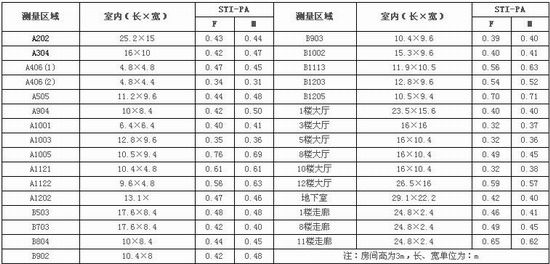
It can be seen from the measurement results that most of the classrooms in the new teaching main building and the public broadcasting system STP-PA in the halls and corridors with public broadcasting systems are below 0.5, and only the public broadcasting system STP- obtained in a very small measurement area. PA is higher than 0.7. This measurement result indicates that the public broadcasting system engineering technical indicators in the new teaching building are relatively low overall, and the public broadcasting system STP-PA ranks in the two levels of passing and poor.
The public transport system's acoustic characteristics indicators in the "Public Public Broadcasting System Engineering Technical Specification (Draft)" (referred to as the "Draft") suggest that the language transmission index of the first, second and third level service broadcasts (emergency broadcast) should be greater than 0.75, respectively. 0.65, 0.50 [1]. According to the measurement results, it can be seen that the public broadcasting system STP-PA in most areas of the new teaching building is lower than the language transmission index requirement (0.50) of the third-level service broadcasting (emergency broadcasting) recommended by the draft, so the teaching building The internal public address system indicators are not in compliance with the provisions of the Public Technical Specifications for Public Public Address Systems (Draft). Considering the actual needs of the public address system, whether the requirements for the language transmission index of the broadcast in the Draft are appropriate, and whether the grading of the broadcast is practical or not is worth discussing.
3. Room acoustic parameters and their correlation with STI-PA In addition to measuring the language transmission index (STI-PA) of the public address system, indoor acoustic parameters are measured in all types of classrooms, halls and corridors in the building. The main parameters of the measurement are: reverberation time RT, early decay time EDT, and definition C50. Table 2 shows the acoustic parameter measurement results of the classroom.
Table 2, classroom acoustic parameters
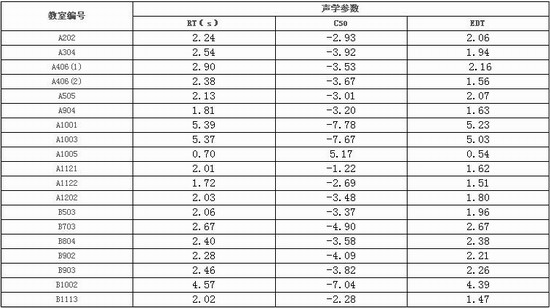
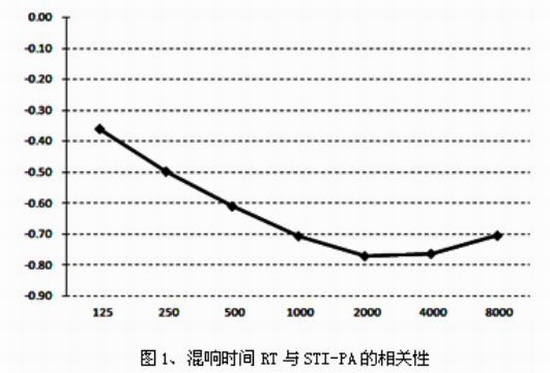
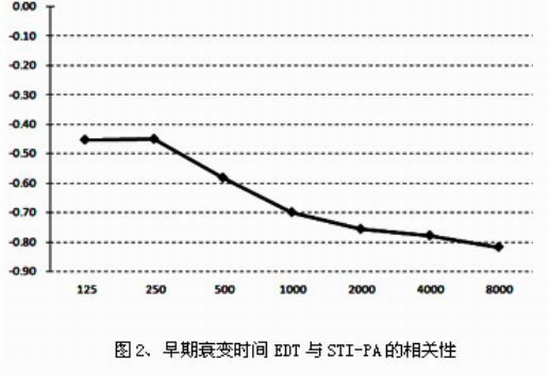
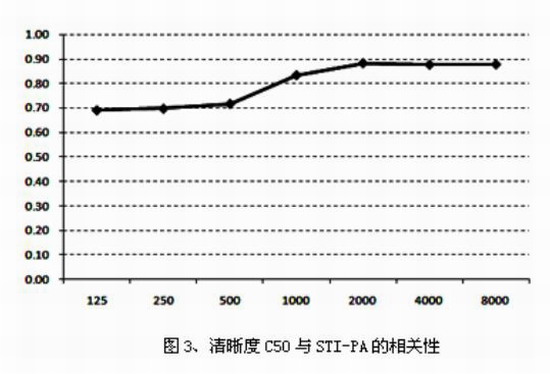
The correlation between the indoor acoustic parameters of each frequency band in the classroom and STI-PA is calculated, and three correlation curves are obtained. Figure 1, Figure 2 and Figure 3 are the correlation curves of parameters RT, EDT, C50 and STI-PA, respectively. For frequency, the ordinate is the correlation coefficient. The results were similar when the female (F) and male (M) STI-PA indices were measured in the classroom. So the result is the average of the male and female acoustic measurements.
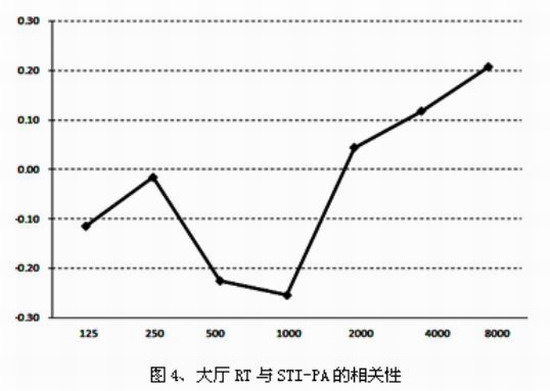
From the classroom acoustic characteristic parameters and STI-PA correlation analysis, the following two points can be seen:
1) In a specific space such as a classroom, the reverberation time RT and EDT have the same trend as the STI-PA correlation curve, and the correlation increases with frequency and is negatively correlated;
2) C50 has a high correlation with STI-PA and is positively correlated.
As can be seen from the above three figures, among the three parameters measured, C50 is higher than the correlation value of STI-PA with respect to RT and EDT, but when the absolute value of the correlation coefficient is high, it cannot be simple. Explain that a parameter determines the STI-PA index of the public address system, which only indicates that the parameter has a high impact on the STI-PA index. Usually, the public address system STP-PA is associated with some parameters in the room acoustic parameters. Is the result of several parameters working together.
It is worth noting that when STI-PA measurement is performed on the hall in the teaching building, the difference in STI-PA obtained when the female (F) signal and the male (M) signal are respectively played is different. The correlation between the acoustic characteristics of the hall and the STI-PA index of the public address system shows a rare feature. As shown in Fig. 4, the correlation curve between the reverberation time RT of the hall and the public broadcasting system STI-PA increases with frequency. Crossed the "0" point. Due to the complicated structure of the halls in the teaching building, the irregular space, the existence of more reflective surfaces, etc., the acoustic characteristics of the hall are complicated, so the correlation curves in Figure 4 and Figure 1 are completely different, which also explains the different space environments. It has different related characteristics from the public broadcasting system STI-PA. At the same time, because the data measured in the hall is far less than the data measured by the classroom, the result shown in Figure 4 is only a special case. The content disclosed in this special case is worthy of the relationship between the indoor acoustic parameters of the complex space and the STI-PA. Further discussion.
4. Summary Through the survey of STI-PA and classroom acoustic parameters of the public broadcasting system in the newly built teaching building of Communication University of China, it is shown that the STI-PA values ​​of most places in the building are below 0.5, which does not reach the "Public Broadcasting System Engineering". Third-level service broadcast (emergency broadcast) language transmission index value requirements as recommended in the Technical Specifications (Draft).
Through the correlation between the acoustic characteristics of the classrooms, halls and other spaces in the teaching building and the STI-PA index of the public broadcasting system, it can be seen that in the space of the classroom, the reverberation time RT and the early decay time EDT are related to STI-PA. The curve trend is approximate and negatively correlated. The absolute value of the correlation coefficient increases with increasing frequency; the definition C50 is highly correlated with STI-PA. In the space such as the hall, the acoustic characteristics and STI-PA correlation show different characteristics from the classroom space, and further analysis is needed.
references
[1] "Public Public Broadcasting System Engineering Technical Specification (Draft)", P15 carried out a number of classrooms, halls, corridors and other areas in a new teaching building in accordance with the requirements of the "Public Public Broadcasting System Engineering Technical Specification (Draft)" measuring. Correlate analysis of the measured language transmission index and indoor acoustic parameters. The contribution of room acoustic parameters to the language transmission index and the standard setting of the language transmission index of the public address system of the classroom space are discussed.
1. Introduction The public address system has been widely installed in school campuses and in teaching buildings and office buildings for functions such as service broadcasting, emergency broadcasting or alarming. However, there is currently no relevant specification for reference and implementation. The language transmission index of the public broadcasting system should be classified and quantified to have practical operability and applicability. There is a certain correlation between the language transmission index of the public address system and the acoustic parameters of the indoor space. For example, the reverberation time RT, the definition C50, and the early decay time EDT can affect the indoor speech intelligibility and intelligibility. Different kinds of spatial environments have different acoustic parameters, and their correlation with speech intelligibility also has different characteristics. Therefore, in the development of relevant parameter standards for public address systems, it is necessary to investigate and analyze the actual public address system. This paper makes a comprehensive measurement of the language transmission index (STI-PA) of the public broadcasting system of the new teaching main building of Communication University of China and the indoor acoustic parameters of the classroom space in which the public broadcasting system is installed. The Public Address System Engineering Technical Specification provides some practical reference data.
2. Measurement of STI-PA The new semester building of the Communication University of China is put into use in the new semester. The entire building has a variety of classrooms with different functions, including many public spaces such as foyer, corridor, and rest area. The measurement was carried out under the condition that the building was completed and the public broadcasting system was commissioned, but it was not officially delivered to the school. The measurement is empty field measurement, and there is no one in the classroom. The indoor acoustic measuring equipment is the BK2260 and BSW acoustic measuring system. The language transmission index was measured using the STI-PA measurement software carried by the IE-35 audio frequency measuring instrument, and the STI-PA was used instead of the language transmission index (STI). The public broadcasting system is turned on in the teaching building, and the female voice (F) and male (M) excitation signals of the IE-35 are separately played, and the STI-PA in two cases is measured respectively. The measurement results and the area of ​​the measurement area are shown in Table 1:
Table 1. Indoor STP-PA measurement results of the new teaching building of Communication University of China

It can be seen from the measurement results that most of the classrooms in the new teaching main building and the public broadcasting system STP-PA in the halls and corridors with public broadcasting systems are below 0.5, and only the public broadcasting system STP- obtained in a very small measurement area. PA is higher than 0.7. This measurement result indicates that the public broadcasting system engineering technical indicators in the new teaching building are relatively low overall, and the public broadcasting system STP-PA ranks in the two levels of passing and poor.
The public transport system's acoustic characteristics indicators in the "Public Public Broadcasting System Engineering Technical Specification (Draft)" (referred to as the "Draft") suggest that the language transmission index of the first, second and third level service broadcasts (emergency broadcast) should be greater than 0.75, respectively. 0.65, 0.50 [1]. According to the measurement results, it can be seen that the public broadcasting system STP-PA in most areas of the new teaching building is lower than the language transmission index requirement (0.50) of the third-level service broadcasting (emergency broadcasting) recommended by the draft, so the teaching building The internal public address system indicators are not in compliance with the provisions of the Public Technical Specifications for Public Public Address Systems (Draft). Considering the actual needs of the public address system, whether the requirements for the language transmission index of the broadcast in the Draft are appropriate, and whether the grading of the broadcast is practical or not is worth discussing.
3. Room acoustic parameters and their correlation with STI-PA In addition to measuring the language transmission index (STI-PA) of the public address system, indoor acoustic parameters are measured in all types of classrooms, halls and corridors in the building. The main parameters of the measurement are: reverberation time RT, early decay time EDT, and definition C50. Table 2 shows the acoustic parameter measurement results of the classroom.
Table 2, classroom acoustic parameters




The correlation between the indoor acoustic parameters of each frequency band in the classroom and STI-PA is calculated, and three correlation curves are obtained. Figure 1, Figure 2 and Figure 3 are the correlation curves of parameters RT, EDT, C50 and STI-PA, respectively. For frequency, the ordinate is the correlation coefficient. The results were similar when the female (F) and male (M) STI-PA indices were measured in the classroom. So the result is the average of the male and female acoustic measurements.

From the classroom acoustic characteristic parameters and STI-PA correlation analysis, the following two points can be seen:
1) In a specific space such as a classroom, the reverberation time RT and EDT have the same trend as the STI-PA correlation curve, and the correlation increases with frequency and is negatively correlated;
2) C50 has a high correlation with STI-PA and is positively correlated.
As can be seen from the above three figures, among the three parameters measured, C50 is higher than the correlation value of STI-PA with respect to RT and EDT, but when the absolute value of the correlation coefficient is high, it cannot be simple. Explain that a parameter determines the STI-PA index of the public address system, which only indicates that the parameter has a high impact on the STI-PA index. Usually, the public address system STP-PA is associated with some parameters in the room acoustic parameters. Is the result of several parameters working together.
It is worth noting that when STI-PA measurement is performed on the hall in the teaching building, the difference in STI-PA obtained when the female (F) signal and the male (M) signal are respectively played is different. The correlation between the acoustic characteristics of the hall and the STI-PA index of the public address system shows a rare feature. As shown in Fig. 4, the correlation curve between the reverberation time RT of the hall and the public broadcasting system STI-PA increases with frequency. Crossed the "0" point. Due to the complicated structure of the halls in the teaching building, the irregular space, the existence of more reflective surfaces, etc., the acoustic characteristics of the hall are complicated, so the correlation curves in Figure 4 and Figure 1 are completely different, which also explains the different space environments. It has different related characteristics from the public broadcasting system STI-PA. At the same time, because the data measured in the hall is far less than the data measured by the classroom, the result shown in Figure 4 is only a special case. The content disclosed in this special case is worthy of the relationship between the indoor acoustic parameters of the complex space and the STI-PA. Further discussion.
4. Summary Through the survey of STI-PA and classroom acoustic parameters of the public broadcasting system in the newly built teaching building of Communication University of China, it is shown that the STI-PA values ​​of most places in the building are below 0.5, which does not reach the "Public Broadcasting System Engineering". Third-level service broadcast (emergency broadcast) language transmission index value requirements as recommended in the Technical Specifications (Draft).
Through the correlation between the acoustic characteristics of the classrooms, halls and other spaces in the teaching building and the STI-PA index of the public broadcasting system, it can be seen that in the space of the classroom, the reverberation time RT and the early decay time EDT are related to STI-PA. The curve trend is approximate and negatively correlated. The absolute value of the correlation coefficient increases with increasing frequency; the definition C50 is highly correlated with STI-PA. In the space such as the hall, the acoustic characteristics and STI-PA correlation show different characteristics from the classroom space, and further analysis is needed.
references
[1] "Public Public Broadcasting System Engineering Technical Specification (Draft)", P15 carried out a number of classrooms, halls, corridors and other areas in a new teaching building in accordance with the requirements of the "Public Public Broadcasting System Engineering Technical Specification (Draft)" measuring. Correlate analysis of the measured language transmission index and indoor acoustic parameters. The contribution of room acoustic parameters to the language transmission index and the standard setting of the language transmission index of the public address system of the classroom space are discussed.
1. Introduction The public address system has been widely installed in school campuses and in teaching buildings and office buildings for functions such as service broadcasting, emergency broadcasting or alarming. However, there is currently no relevant specification for reference and implementation. The language transmission index of the public broadcasting system should be classified and quantified to have practical operability and applicability. There is a certain correlation between the language transmission index of the public address system and the acoustic parameters of the indoor space. For example, the reverberation time RT, the definition C50, and the early decay time EDT can affect the indoor speech intelligibility and intelligibility. Different kinds of spatial environments have different acoustic parameters, and their correlation with speech intelligibility also has different characteristics. Therefore, in the development of relevant parameter standards for public address systems, it is necessary to investigate and analyze the actual public address system. This paper makes a comprehensive measurement of the language transmission index (STI-PA) of the public broadcasting system of the new teaching main building of Communication University of China and the indoor acoustic parameters of the classroom space in which the public broadcasting system is installed. The Public Address System Engineering Technical Specification provides some practical reference data.
2. Measurement of STI-PA The new semester building of the Communication University of China is put into use in the new semester. The entire building has a variety of classrooms with different functions, including many public spaces such as foyer, corridor, and rest area. The measurement was carried out under the condition that the building was completed and the public broadcasting system was commissioned, but it was not officially delivered to the school. The measurement is empty field measurement, and there is no one in the classroom. The indoor acoustic measuring equipment is the BK2260 and BSW acoustic measuring system. The language transmission index was measured using the STI-PA measurement software carried by the IE-35 audio frequency measuring instrument, and the STI-PA was used instead of the language transmission index (STI). The public broadcasting system is turned on in the teaching building, and the female voice (F) and male (M) excitation signals of the IE-35 are separately played, and the STI-PA in two cases is measured respectively. The measurement results and the area of ​​the measurement area are shown in Table 1:
Table 1. Indoor STP-PA measurement results of the new teaching building of Communication University of China

It can be seen from the measurement results that most of the classrooms in the new teaching main building and the public broadcasting system STP-PA in the halls and corridors with public broadcasting systems are below 0.5, and only the public broadcasting system STP- obtained in a very small measurement area. PA is higher than 0.7. This measurement result indicates that the public broadcasting system engineering technical indicators in the new teaching building are relatively low overall, and the public broadcasting system STP-PA ranks in the two levels of passing and poor.
The public transport system's acoustic characteristics indicators in the "Public Public Broadcasting System Engineering Technical Specification (Draft)" (referred to as the "Draft") suggest that the language transmission index of the first, second and third level service broadcasts (emergency broadcast) should be greater than 0.75, respectively. 0.65, 0.50 [1]. According to the measurement results, it can be seen that the public broadcasting system STP-PA in most areas of the new teaching building is lower than the language transmission index requirement (0.50) of the third-level service broadcasting (emergency broadcasting) recommended by the draft, so the teaching building The internal public address system indicators are not in compliance with the provisions of the Public Technical Specifications for Public Public Address Systems (Draft). Considering the actual needs of the public address system, whether the requirements for the language transmission index of the broadcast in the Draft are appropriate, and whether the grading of the broadcast is practical or not is worth discussing.
3. Room acoustic parameters and their correlation with STI-PA In addition to measuring the language transmission index (STI-PA) of the public address system, indoor acoustic parameters are measured in all types of classrooms, halls and corridors in the building. The main parameters of the measurement are: reverberation time RT, early decay time EDT, and definition C50. Table 2 shows the acoustic parameter measurement results of the classroom.
Table 2, classroom acoustic parameters




The correlation between the indoor acoustic parameters of each frequency band in the classroom and STI-PA is calculated, and three correlation curves are obtained. Figure 1, Figure 2 and Figure 3 are the correlation curves of parameters RT, EDT, C50 and STI-PA, respectively. For frequency, the ordinate is the correlation coefficient. The results were similar when the female (F) and male (M) STI-PA indices were measured in the classroom. So the result is the average of the male and female acoustic measurements.

From the classroom acoustic characteristic parameters and STI-PA correlation analysis, the following two points can be seen:
1) In a specific space such as a classroom, the reverberation time RT and EDT have the same trend as the STI-PA correlation curve, and the correlation increases with frequency and is negatively correlated;
2) C50 has a high correlation with STI-PA and is positively correlated.
As can be seen from the above three figures, among the three parameters measured, C50 is higher than the correlation value of STI-PA with respect to RT and EDT, but when the absolute value of the correlation coefficient is high, it cannot be simple. Explain that a parameter determines the STI-PA index of the public address system, which only indicates that the parameter has a high impact on the STI-PA index. Usually, the public address system STP-PA is associated with some parameters in the room acoustic parameters. Is the result of several parameters working together.
It is worth noting that when STI-PA measurement is performed on the hall in the teaching building, the difference in STI-PA obtained when the female (F) signal and the male (M) signal are respectively played is different. The correlation between the acoustic characteristics of the hall and the STI-PA index of the public address system shows a rare feature. As shown in Fig. 4, the correlation curve between the reverberation time RT of the hall and the public broadcasting system STI-PA increases with frequency. Crossed the "0" point. Due to the complicated structure of the halls in the teaching building, the irregular space, the existence of more reflective surfaces, etc., the acoustic characteristics of the hall are complicated, so the correlation curves in Figure 4 and Figure 1 are completely different, which also explains the different space environments. It has different related characteristics from the public broadcasting system STI-PA. At the same time, because the data measured in the hall is far less than the data measured by the classroom, the result shown in Figure 4 is only a special case. The content disclosed in this special case is worthy of the relationship between the indoor acoustic parameters of the complex space and the STI-PA. Further discussion.
4. Summary Through the survey of STI-PA and classroom acoustic parameters of the public broadcasting system in the newly built teaching building of Communication University of China, it is shown that the STI-PA values ​​of most places in the building are below 0.5, which does not reach the "Public Broadcasting System Engineering". Third-level service broadcast (emergency broadcast) language transmission index value requirements as recommended in the Technical Specifications (Draft).
Through the correlation between the acoustic characteristics of the classrooms, halls and other spaces in the teaching building and the STI-PA index of the public broadcasting system, it can be seen that in the space of the classroom, the reverberation time RT and the early decay time EDT are related to STI-PA. The curve trend is approximate and negatively correlated. The absolute value of the correlation coefficient increases with increasing frequency; the definition C50 is highly correlated with STI-PA. In the space such as the hall, the acoustic characteristics and STI-PA correlation show different characteristics from the classroom space, and further analysis is needed.
references
[1] "Public Public Address System Engineering Technical Specification (Draft)", P15
6.35MM Power+ Signal Power Connector
power connector is used in power module system. It can select the matching power + signal connector according to the need. The feature is that the number of power and signal contacts and the matching sequence can be selected arbitrarily while keeping the connector size and contact core number unchanged.
Plug (male) / socket (female) can be installed at 90 or 180 degrees. It supports mixed or independent combination of signal and power. The quantity range of power and signal is (2-16) pin and (12-128) pin respectively
Product features
High temperature resistant, glass fiber reinforced and flame retardant polyester is used as insulation material
Copper gold composite conductor with high conductivity is used, and the contact area of the conductor is plated with gold
It adopts shrapnel contact, which has the characteristics of integration, small volume, large current carrying capacity, soft plug-in, blind plug-in, self guidance and high dynamic contact reliability. This series of products can be interchanged with FCI's powerblade series and Tyco's multi-beam series
There are three sizes of center distance of power contact: 5.08mm, 6.35mm and 7.62mm
The length of power hole / signal pin can be selected in two sizes. The power rated current is 45A and the signal rated current is 2.5A
6.35MM Power+ Signal Power Connector
ShenZhen Antenk Electronics Co,Ltd , https://www.atkconnectors.com